2022 Szeged, Hungary
Key Info
Conference Dates
22/09/22 — 25/09/22
After two years of online conferences, we are happy to welcome at the IWSG annual conference in Szeged, Hungary.
IWSG is an organisation which is committed to diversity and inclusivity. Everyone is welcome to become a member or to join us at our conferences, irrespective of their age, ethnicity, gender, sexuality, nationality and socio-economic status.
If you have any questions regarding our annual meetings, please contact us via conference@waderstudygroup.org.
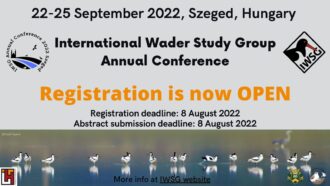
Location
The Szegedi Ifjúsági Ház was built in the 70s and represented the architectural characteristics of the era. The ceremonial opening was on 21 March 1979. During the years there were minor reconstruction works in the building but with time a major re-building work became essential. After major reconstruction, the new building’s ceremonial opening was on 3 September 2008 and it was renamed IH Rendezvényközpont.
With its modern and youthful style, it is a popular venue for different types of outings, such as cultural events, business outings, balls and conferences.
Apart from being part of the town’s cultural life for over 50 years, this venue is popular due to its proximity both to the Tisza river and the city centre.
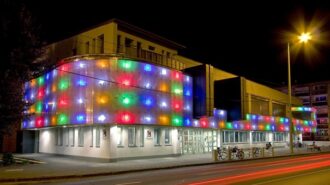
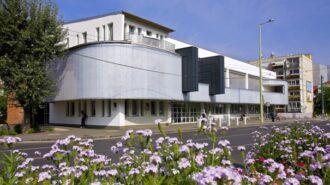
Address: Felső Tisza-Part 2, 6721, Szeged, Hungary
The conference programme includes three workshops:
Using Audiomoths to monitor breeding waders by David Jarret,
the final workshop of Project Godwit by Rebecca Lee &
Shorebirds in the Arctic: Changes, Threats and Challenges by Vojtěch Kubelka.

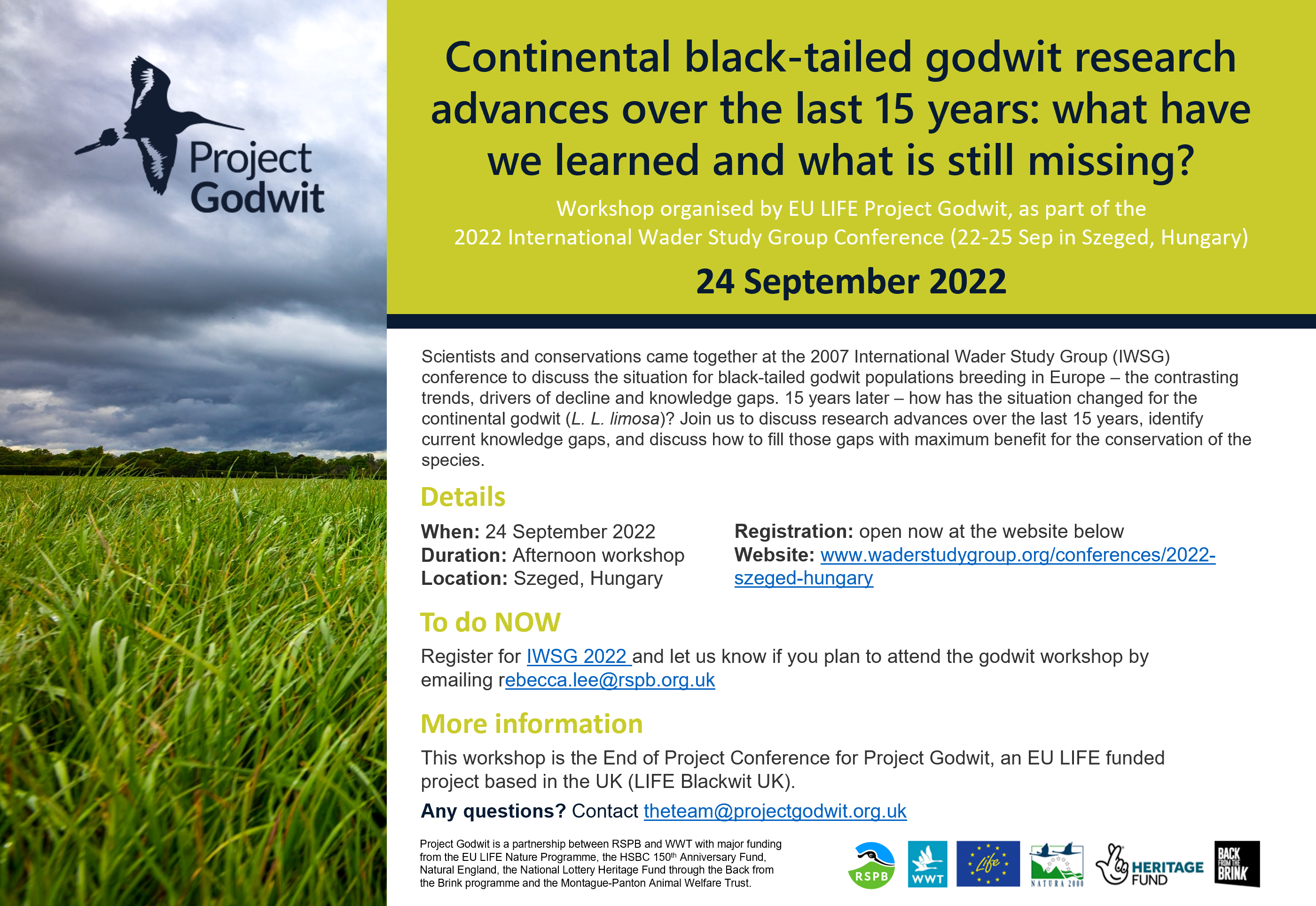
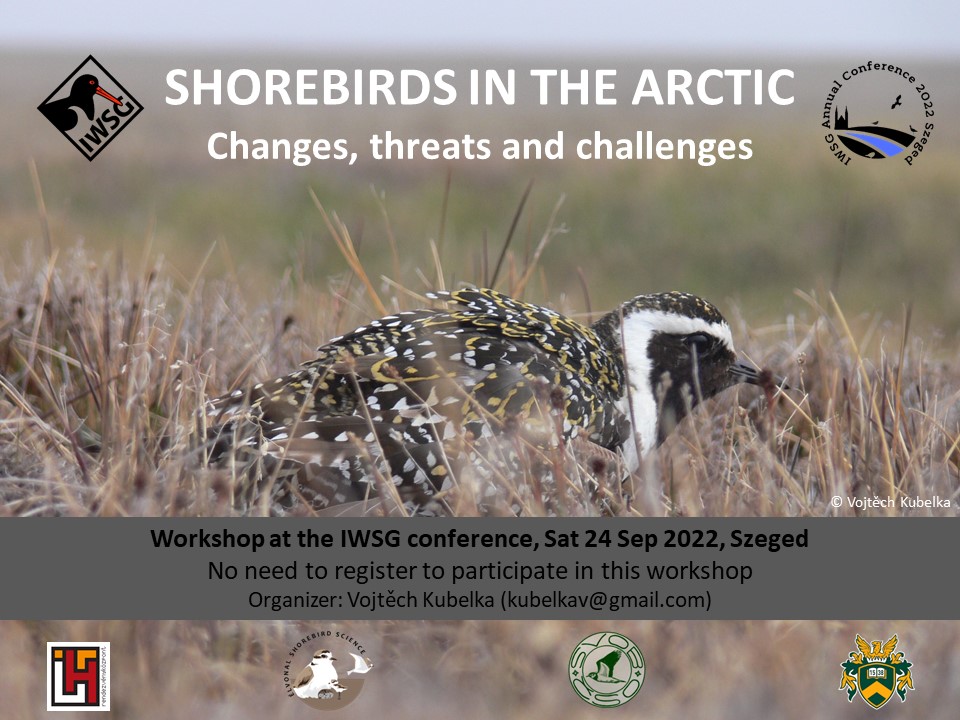
All excursions will happen on 25 September and need at least 10 Participants. Further details (for eg.: pick-up time and location) will be informed via e-mail a few days before the excursion.
 Excursion A: Birding trip to Lake Fehér and Tisza-völgyi Visitor Centre (half a day, Max. 30 participants, Min. 10)
Excursion A: Birding trip to Lake Fehér and Tisza-völgyi Visitor Centre (half a day, Max. 30 participants, Min. 10)
Lake Fehér is a protected Ramsar site, situated in the Pusztaszer Landscape Protection Area.
The Pusztaszer Landscape Protection Area is one of the largest landscape protection areas in Hungary (22 225 ha). It has a diverse ecological landscape alongside the right-hand side floodplain of Tisza and the former floodplain area beyond the embankments. Five thousand hectares of the area, including Labodár, Sas-ér, Büdös-szék, Baks puszta, Lake Csaj and Lake Fehér, are internationally recognized wetlands according to the Ramsar Convention.
The Labodár and Atka backwaters were created during river regulations in the 19th century. Low-lying depressions used to contain soda lakes, some of which are still in intact condition (Büdös-szék), while others have been transformed into fishponds (Lake Csaj). Sas-ér is a forest reserve and most of it is strictly protected. A large proportion of the Landscape Protection Area is covered by grasslands and croplands that are managed extensively or with traditional techniques. These areas are prime stop-over and feeding sites for passage migrants, primarily cranes and geese. Botanical and zoological studies confirmed that this area harbours the most valuable saline steppe remnants of the Lower Tisza region. Since the area lies in the interface of the Tisza Valley and the sandy region of the Danube-Tisza Interfluve, both sand and saline steppe plant associations occur in the protected area.
Tisza valley Visitor Centre’s permanent exhibition demonstrates the protected natural assets of the lower Tisza area. Walking along the picturesque Sirály path leads to a watch tower where visitors can have a good look at Lake Fehér and can explore the surrounding wildlife. The Visitor Centre is a popular venue for public environmental education, plus it is a starting point for bike and walking tours.
Lake Fehér is lying north of Szeged. It is the largest (over 2400 ha) fishpond system in the area; it has been under protection since 1939. By that time, the original soda lakes had mostly been transformed into fishponds. Despite the transformation, the area still harbours rich birdlife. Over 280 bird species have been recorded in and around the lakes. The former saline swamps provided feeding and roosting site for birds but this is efficiently substituted by the muddy surfaces of temporarily drained fishpond units. In winter, when all other water bodies are covered in ice, birds can still find some open water here, where they can drink and rest. Lake Fehér has an island, the Korom Island, which is used by gulls for nesting. Black-headed Gull is the most common nesting species but several hundred pairs of Mediterranean Gulls can also be found here. The largest masses of birds arrive in late summer and during autumn. Common Cranes join tens of thousands of flocks of geese and ducks in mid-October. In September, a large number of migrating species, including shorebirds use the site.
Source: Kiskunsági National Park https://www.knp.hu/en/landscape-protection-areas
Photos: Krisztián Ábrahám and Kiskunsági National Park archive
The price contains the fee for the transportation from Szeged to Szatymaz and back, the admission fee for the visitor centre’s exhibition and the fee for the guided birding tour at the lake.
 Excursion B: Birding trip to Lake Csaj (half a day, Max. 30 participants, Min. 10)
Excursion B: Birding trip to Lake Csaj (half a day, Max. 30 participants, Min. 10)
Lake Csaj is located 50 km away from Szeged and part of the Pusztaszer Landscape Protection Area. *more about Pusztaszer Landscape protection area in Excursion A description* Together with the fishponds of Síróhegy the total expanse of the fishpond system is 1200 ha. Originally these were saline lakes until they started to transform into fishponds in 1964. Today it is a system of smaller and larger fishponds with reed beds and bulrush margins.
A large variety of breeding water bird species can be found here, such as Great Egret (Egretta alba), Little Egret (Egretta garzetta), Grey Heron (Ardea cinerea) and Purple Heron (Ardea purpurea). At one of the lakes on the gull’s island, there are colonies of two gull species (Common Black-headed Gull (Larus ridibundus) and Mediterranean Gull (Larus melanocephalus)).
Reed margins of Lake Csaj provide a safe nesting area for many duck species, like Red-crested Pochard (Netta rufina). During the winter many northern species, such as Common Goldeneye (Bucephala clangula), Greater Scaup (Aythya marila), Smew (Mergellus albellus) Common merganser (Mergus merganser) and Black-throated Loon (Gavia arctica), choose the lake for over-wintering. Red-breasted Geese (Branta ruficollis) and Lesser White-fronted Geese (Anser erythropus) also visit the lake during winter in large numbers.
Due to the close proximity of the Tisza River and its floodplain, nesting White-tailed Eagles (Haliaetus albicilla) are often foraging around the lakes.
Source: Kiskunsági National Park https://www.knp.hu/en/landscape-protection-areas
Photos: Krisztián Ábrahám and Kiskunsági National Park archive
The price contains the fee for the transportation from Szeged to Lake Csaj and back, and the fee for the guided birding tour at the lake and its surroundings.
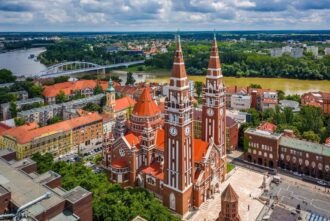 Excursion C: Sightseeing Szeged (1.5-2.0 hrs, Max. 40 participants)
Excursion C: Sightseeing Szeged (1.5-2.0 hrs, Max. 40 participants)
A guided sightseeing tour offers you a walking tour across Szeged. All there is worth to visit and hear about the history, culture and other curiosities.
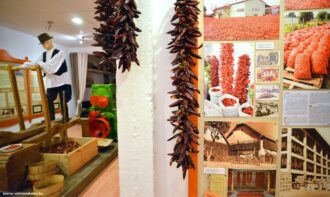 Excursion D: Gastro tour-Paprika Mill and Museum, wine tasting (half a day, Max. 40 participants)
Excursion D: Gastro tour-Paprika Mill and Museum, wine tasting (half a day, Max. 40 participants)
The gastro tour contains two locations. First, there will be a visit to the Paprika Mill and Museum in Röszke. Here you can learn more about the origin and usage of paprika, its science and history, and its cultural value.
The second location will be the Tóth Cellar at Ásotthalom. Here you will have the opportunity to taste the 5 most characteristic wines of the area and learn about the wine making process.
More info about the Paprika Mill and Museum: https://www.paprikamolnar.hu/english/
The price includes the transport from Szeged to Röszke and Ásotthalom and back, the fee for the guided tour in the Paprika Museum and the fee for the wine tasting.
Please note that booking accommodation is each participant’s own responsibility. Please find the organizers’ suggestions below.
- Tisza Hotel (three-star hotel, from 52 EUR per person per night): http://www.tiszahotel.hu/?lang=en
- Hajós Ház (apartment, 18-75 EUR per person per night): http://www.hajoshaz.eu/index_eng.html
- Dóm Hotel (four-star hotel, from 62 EUR per person per night): https://domhotelszeged.info/en/
- Novotel Szeged (four-star hotel, from 65 EUR per person per night): https://all.accor.com/hotel/2996/index.en.shtml?utm_campaign=seo+maps&utm_medium=seo+maps&utm_source=google+Maps
- Eötvös Lóránd Kollégium (student hotel, prices are calculated individually, for prices please contact with accommodation): http://www.eotvos.u-szeged.hu/accommodation
- Tisza Sport Hotel (casual hotel, 32-73 EUR per person per night and includes breakfast): http://www.tiszasporthotel.hu/?lang=en
- Maya Panzió (casual hotel, 16-63 EUR per person per night): https://mayapanzio.hu/kapcsolat
This list includes accommodation of a wide price range. If they are not attractive enough, the better-known Airbnb, booking.com and TripAdvisor are offering further options at Szeged.
Download the Full programme of the 2022 Conference
Thursday 22 September 2022
Pre-conference symposium: Breeding systems in a changing world
Afternoon – registration
Evening – welcome dinner (and registration)
Friday 23 September 2022 –
Annual general meeting
Full scientific programme
Saturday 24 September 2022
Full scientific programme & three workshops
Sunday 25 September 2022
Excursions
How to get to Szeged?
Szeged is situated in the South-East part of Hungary. It is easily accessible by train or road from most major Hungarian cities.
Travelling to an international conference incurs considerable carbon emissions. To reduce this, please consider coming to Szeged by land transport. In addition to public transport, the central European location of Szeged facilitates the possibility of driving to the conference. If you wish to share your car with a colleague, or are looking for a ride, please fill in this car pooling form.
You can also fill this form if you are looking for company for a train/bus trip.
Travelling by bus
You can get to Szeged by bus from most of the major Hungarian cities. International buses are also available. Please find the timetables and prices below:
Inland: https://www.volanbusz.hu/en
Travelling by train
You can travel by train to Szeged. From Budapest Nyugati Railway Station, there are direct trains every hour.
International trains are available which usually stop at Budapest. Please note that you may have to change railway station at Budapest during your route.
Timetable of inland trains: https://jegy.mav.hu/
International timetable: https://www.thetrainline.com/
Travelling by car
Szeged is located 170 km south of Budapest and the connection is provided by the M5 motorway and the European route E75.
Travel by plane
From Budapest Liszt Ferenc Airport
You will arrive at 2A terminal of Liszt Ferenc Airport. You can find the Ferihegy Railway Station (Budapest Airport) near this terminal, where you should take the train to get to Szeged.
Between terminal 2A and Ferihegy Railway Station, there is the bus 200E (timetable: https://bkk.hu/apps/menetrendek/storage/menetrendek/1315/175621.pdf ). A ticket for this bus costs 450 HUF when purchasing it on the ride with cash. Or you can buy the ticket from a purple BKK machine near the exit at terminal 2A for 350 HUF. The machine should accept credit cards but surely works with HUF. The ride to Ferihegy Railway Station by bus 200E from Liszt Ferenc Airport takes 15-20 min.
Taxi service is also available from the airport to Ferihegy Railway Station: https://www.bud.hu/en/passengers/transport/airport_transfer_and_other_services/taxi
From Ferihegy Railway Station, direct InterCity trains run to Szeged every hour.
Travel time: approx. 2 hours, one one-way ticket costs about 4000 HUF. Please note that seat reservation is mandatory on these trains.
At the railway station, you can find a ticket office to purchase your train ticket to Szeged; there are also yellow ticket machines on the platform, or you can buy your ticket online on the following website: https://jegy.mav.hu/
Train timetable: https://jegy.mav.hu/
Airport transfer is also available from Liszt Ferenc Airport to Szeged. Make sure to book your ride in advance. https://szegedtranszfer.hu/viteldij (e-mail: info@szegedtranszfer.hu)
From Debrecen Airport
Debrecen Airport is a small airport with one terminal. From Debrecen Airport, you should get to Debrecen Railway Station to get a train to Szeged.
Between Debrecen Airport and Debrecen Railway Station, there is a shuttle bus Airport 1 (timetable: http://dkv.ptss.hu/ScheduleDetail/#lm//Airport%201/V/0/hu). Bus tickets are to be purchased on the bus for 450 HUF, in cash. The bus ride from Debrecen Airport to Debrecen Railway Station is approximately 12 min.
Taxi service is also available from the airport to Debrecen Railway Station or to any other location in the city: https://www.debrecenairport.com/en/transport/taxi
InterCity trains are running from Debrecen Railway Station to Szeged every hour. Please note that this train ride includes one exchange at Cegléd.
Travel time: approx. 3 hours, one one-way ticket costs approximately 4000 HUF. Please note that seat reservation is mandatory on these trains.
At the railway station, you can find ticket offices to buy your train ticket to Szeged; there are also some automated ticket machines or you can purchase it online on the following website: https://jegy.mav.hu/
Train timetable: https://jegy.mav.hu/
Airport transfer is available from Debrecen Airport to Szeged. Make sure to book your ride in advance. https://szegedtranszfer.hu/viteldij (e-mail: info@szegedtranszfer.hu)
Each year the IWSG supports up to five low-income country delegates’ participation at the Annual Conference with €400. We have compiled a short form that will be the basis for prioritizing the applications.
Please note that we can only support people whose work is related to waders (species belonging to suborders Scolopaci, Thinocori, Chionidi and Charadrii). Also, to qualify for the scholarship, you must give an oral or poster presentation at the conference. The deadline for the application is the 31st of July and we will let the applicants know of the results as soon as possible. Click the link below to apply for the grant:
IWSG conference grant application
For questions, please contact the conference team via conference@waderstudygroup.com
IWSG 2022 competition for tracking studies
![]()

Hunan Global Messenger Technology Co., Ltd. and IWSG are going to hold the second tracking study competition during the conference. The winners will be rewarded with five lightweight GPS/GSM transmitters to be used in their proposed research in the competition.
The competition is open to all conference participants. Please submit a proposal abstract (200 words or less) to the conference scientific committee, briefly describing your plan and expected results of the tracking study. A winner will be selected based on three criteria:
Feasibility
Knowledge gained
Impact
During the conference, we will hold a special session in which competitors will give a 3-minute speedy presentation (with one slide) on their proposal. The scientific committee will then announce the first winner. Conference participants after the speedy presentations will vote for a second winner. The criteria for voting are the same as above.
Please register for IWSG 2022 and submit your proposal abstract for tracking study via: https://forms.gle/BbqfxHQz8hTY9Srt9
Deadline: the 15th of September 2022
More information, please contact: drewbingrun@outlook.com. Please visit http://en.hqxs.net/cpzs/Knapsack/ for product details.
![]()
BREEDING SYSTEMS IN A CHANGING WORLD
Satellite symposium of IWSG Conference, 22 September 2022, Szeged
Organisers: Tamás Székely, William Jones & Vojtěch Kubelka

Shorebirds exhibit an unusual variation in their mating systems and parenting, and this variation has attracted interests from ecologists, evolutionary biologists and sociobiologists. However, the world is rapidly changing due to human activities that include changes in breeding habitats, climatic variations, and various human-induced selective pressures such as increased predation and/or disturbance on breeding grounds. The aim of this full-day symposium is to overview ongoing research programmes that are uncovering the ecological, evolutionary and anthropogenic effects on shorebird breeding behaviour that include – but not restricted to – timing of breeding, mate choice and courtship behaviour, pair-bonding, incubation, chick care and other aspects of breeding ecology. We will also encourage large-scale collaborative studies to uncover the evolutionary drivers of breeding system variations, and investigate how these studies can lead to conservation actions that benefit shorebirds by protecting their breeding habitats.
The symposium is open to contributions from anyone with interest in shorebird behaviour, ecology and conservation. We encourage potential contributors and participants to contact the symposium organisers, ideally Vojtěch Kubelka kubelkav@gmail.com.
The symposium is supported by ÉLVONAL Shorebird Science project (elvonalshorebirds.com), which targets understanding the sex roles variation using shorebirds as excellent model system.
